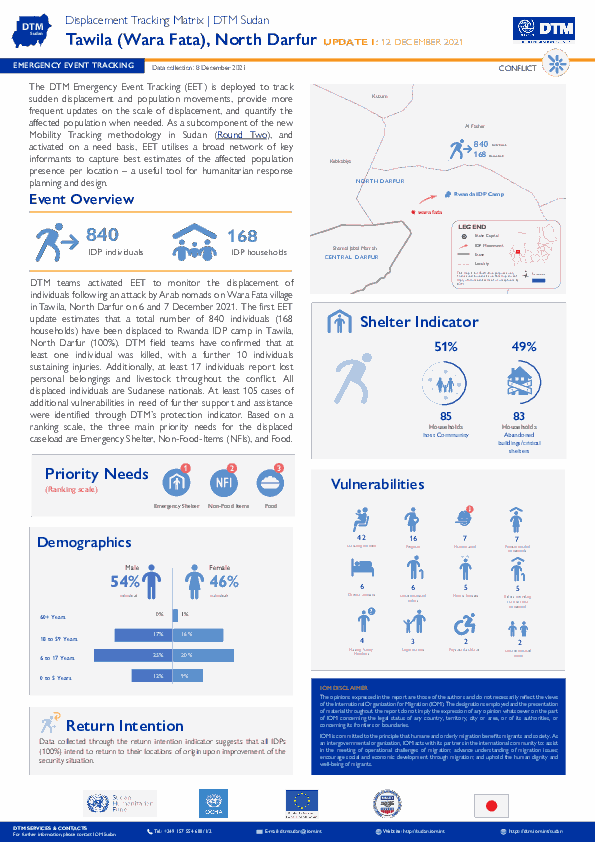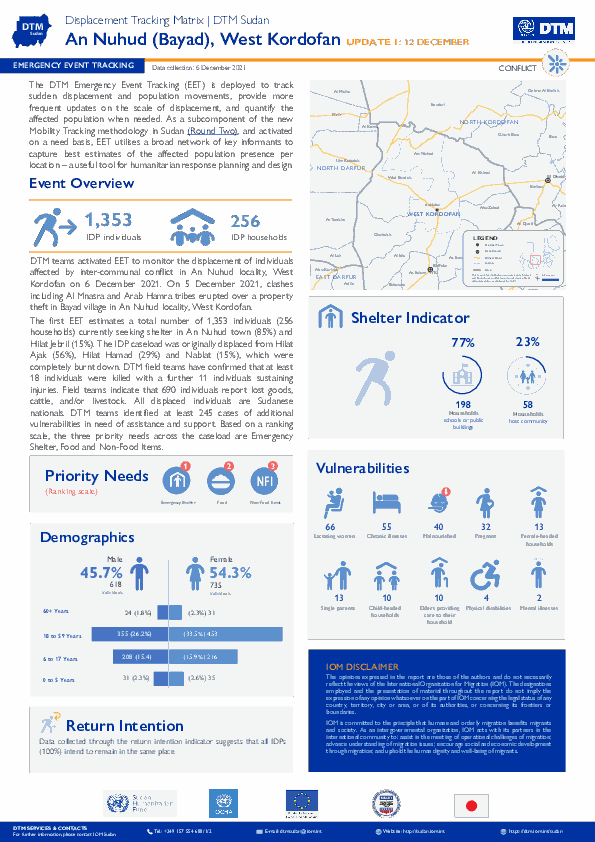-
Countries
-
Data and Analysis
-
Special Focus
-
Crisis Responses

Contact
DTM Sudan; dtmsudan@iom.int
Language
English
Location
Sudan
Snapshot Date
Dec 08 2021
Activity
- Event Tracking
- Mobility Tracking
The DTM Emergency Event Tracking (EET) is deployed to track sudden displacement and population movements, provide more frequent updates on the scale of displacement, and quantify the affected population when needed. As a subcomponent of the new Mobility Tracking methodology in Sudan (Round Two), and activated on a need basis, EET utilises a broad network of key informants to capture best estimates of the affected population presence per location – a useful tool for humanitarian response planning and design.

Contact
DTM Sudan; dtmsudan@iom.int
Language
English
Location
Sudan
Snapshot Date
Dec 08 2021
Activity
- Mobility Tracking
- Event Tracking
The DTM Emergency Event Tracking (EET) is deployed to track sudden displacement and population movements, provide more frequent updates on the scale of displacement, and quantify the affected population when needed. As a subcomponent of the new Mobility Tracking methodology in Sudan (Round Two), and activated on a need basis, EET utilises a broad network of key informants to capture best estimates of the affected population presence per location – a useful tool for humanitarian response planning and design.
Contact
DTM Yemen, iomyemendtm@iom.int
Location
Yemen
Activity
- Event Tracking
- Mobility Tracking
Period Covered
Dec 13 2021 -Nov 28 2021
From 01 January 2021 to 4 December 2021, IOM Yemen DTM estimates that 21,802 households (HH) (130,812 Individuals) have experienced displacement at least once.
Since the beginning of 2021, DTM also identified 3,814 displaced households who left their locations of displacement and either moved back to their place of origin or another location.
Between 28 November and 04 December 2021, IOM Yemen DTM tracked 234 households (1,404 individuals) displaced at least once.
The top three districts of the top three governorates that saw the highest number of displacements were:
• Taiz (66 HH) – Mawza (48 HH), Salah (6 HH), As Silw (5 HH) districts. Most displacements in the governorate were internal.
• Al Hodeidah (52 HH) – Hays (39 HH), Al Khukhah (13 HH) districts. Most displacements in the governorate were internal.
• Marib (50 HH) – Marib City (36 HH), Marib (14 HH) districts. Most displacements in the governorate were internal.
Most displacements resulted from the increased conflict in the following governorates and districts.
• Taiz (70 HH) – Maqbanah (57 HH), Sharab Ar Rawnah (3 HH), At Taiziyah (3 HH) districts.
• Al Hodeidah (59 HH) – Hays (21 HH), Al Jarrahi (17 HH), At Tuhayta (13 HH) districts.
• Marib (51 HH) – Al Jubah (23 HH), Harib (7 HH), Sirwah (7 HH) districts.
Population Groups
Survey Methodology
Unit of Analysis Or Observation
Type of Survey or Assessment
Keywords
Geographical Scope
Administrative boundaries with available data
The current dataset covers the following administrative boundaries
Contact
DTM Yemen, iomyemendtm@iom.int
Location
Yemen
Activity
- Event Tracking
- Mobility Tracking
Period Covered
Nov 21 2021 -Nov 27 2021
From 01 January 2021 to 27 November 2021, IOM Yemen DTM estimates that 21,392 households (HH) (128,352 Individuals) have experienced displacement at least once.
Since the beginning of 2021, DTM also identified 3,814 displaced households who left their locations of displacement and either moved back to their place of origin or another location.
Between 21 and 27 November 2021, IOM Yemen DTM tracked 259 households (1,554 individuals) displaced at least once. The top three districts of the top three governorates that saw the highest number of displacements were:
• Marib (91 HH) – Marib City (59 HH), Marib (32 HH) districts. Most displacements in the governorate originated from Marib and Shabwah.
• Al Hodeidah (55 HH) – Hays (55 HH) district. Most displacements in the governorate were internal.
• Taiz (46 HH) – Al Makha (10 HH), Jabal Habashi (7 HH), Al Qahirah (7 HH) districts. Most displacements in the governorate originated from Al Hodeidah and Taiz.
Most displacements resulted from the increased conflict in the following governorates and districts.
• Al Hodeidah (82 HH) – Hays (37 HH), Al Jarrahi (21 HH), Jabal Ras (6 HH) districts.
• Marib (66 HH) – Al Jubah (25 HH), Sirwah (14 HH), Harib (14 HH) districts.
• Shabwah (37 HH) – Ayn (22 HH), Bayhan (13 HH), Osaylan (2 HH) districts.
Population Groups
Survey Methodology
Unit of Analysis Or Observation
Type of Survey or Assessment
Keywords
Geographical Scope
Administrative boundaries with available data
The current dataset covers the following administrative boundaries
Contact
DTM Yemen, iomyemendtm@iom.int
Location
Yemen
Activity
- Event Tracking
- Mobility Tracking
Period Covered
Nov 14 2021 -Nov 20 2021
From 01 January 2021 to 20 November 2021, IOM Yemen DTM estimates that 21,007 households (HH) (126,042 Individuals) have experienced displacement at least once.
Since the beginning of 2021, DTM also identified 3,814 displaced households who left their locations of displacement and either moved back to their place of origin or another location.
Between 14 and 20 November 2021, IOM Yemen DTM tracked 497 households (2,982 individuals) displaced at least once. The top three districts of the top three governorates that saw the highest number of displacements were:
• Marib (202 HH) – Marib City (142 HH), Marib (60 HH) districts. Most displacements in the governorate were internal.
• Taiz (96 HH) – Al Makha (89 HH), Al Waziyah (7 HH) districts. All displacements in the governorate orginiated from Al Hodeidah.
• Al Maharah (55 HH) – Al Ghaydhah (52 HH), Sayhut (3 HH) districts. Most displacements in the governorate originated from Taiz and Ibb.
Most displacements resulted from the increased conflict in the following governorates and districts.
• Marib (203 HH) – Al Jubah (169 HH), Sirwah (12 HH), Harib (9 HH) districts.
• Al Hodeidah (169 HH) – At Tuhayta (82 HH), Hays (43 HH), Ad Durayhimi (17 HH) districts.
• Shabwah (34 HH) – Osaylan (19 HH), Bayhan (10 HH), Ayn (5 HH) districts.
Population Groups
Survey Methodology
Unit of Analysis Or Observation
Type of Survey or Assessment
Keywords
Geographical Scope
Administrative boundaries with available data
The current dataset covers the following administrative boundaries
Contact
DTM Cameroon, DTMCameroon@iom.int
Location
Cameroon
Activity
- Mobility Tracking
- Baseline Assessment
Period Covered
Jul 07 2021 -Jul 18 2021
A baseline assessment is a sub-component of mobility tracking. It aims to collect data on IDP, migrant or returnee population presence in a defined administrative area of the country.
Population Groups
Survey Methodology
Unit of Analysis Or Observation
Type of Survey or Assessment
Keywords
Geographical Scope
Administrative boundaries with available data
The current dataset covers the following administrative boundaries

Contact
iabdelgadir@iom.int
Language
English
Location
Sudan
Snapshot Date
Dec 09 2021
Activity
- Event Tracking
The DTM Emergency Event Tracking (EET) is deployed to track sudden displacement and population movements, provide more frequent updates on the scale of displacement, and quantify the affected population when needed. As a subcomponent of the new Mobility Tracking methodology in Sudan (Round Two), and activated on a need basis, EET utilises a broad network of key informants to capture best estimates of the affected population presence per location – a useful tool for humanitarian response planning and design.

Contact
DTM Sudan; dtmsudan@iom.int
Language
English
Location
Sudan
Snapshot Date
Dec 08 2021
Activity
- Event Tracking
- Mobility Tracking
The DTM Emergency Event Tracking (EET) is deployed to track sudden displacement and population movements, provide more frequent updates on the scale of displacement, and quantify the affected population when needed. As a subcomponent of the new Mobility Tracking methodology in Sudan (Round Two), and activated on a need basis, EET utilises a broad network of key informants to capture best estimates of the affected population presence per location – a useful tool for humanitarian response planning and design.

Contact
DTM Sudan; dtmsudan@iom.int
Language
English
Location
Sudan
Snapshot Date
Dec 06 2021
Activity
- Event Tracking
- Mobility Tracking
The DTM Emergency Event Tracking (EET) is deployed to track sudden displacement and population movements, provide more frequent updates on the scale of displacement, and quantify the affected population when needed. As a subcomponent of the new Mobility Tracking methodology in Sudan (Round Two), and activated on a need basis, EET utilises a broad network of key informants to capture best estimates of the affected population presence per location – a useful tool for humanitarian response planning and design.

Contact
DTM Yemen, iomyemendtm@iom.int
Language
English
Location
Yemen
Period Covered
Nov 01 2021
Nov 30 2021
Activity
- Points of Entry (PoE)
HIGHLIGHTS (From 01 to 30 November 2021)
• 204 new cases – 60 new deaths | source: WHO
• Updates on the numbers of new cases in areas controlled by the De Facto Authorities (DFA) based in Sana’a are not available.
• 3,622 non-Yemeni migrants arrived at the Yemeni southern governorates of Lahj, Hadramowt, and Shabwah, and 5,802 Yemeni returnees arrived in Yemen from Saudi Arabia (KSA). (Please see November FMR report for more details)
• No IDP households (HH) reported COVID-19 as the reason of displacement. So far, the total number of IDP HHs who have cited COVID-19 as the primary reason for displacement is 1,559 households.
• On 26 November 2021 the Ministry of Public Health and Population in Aden received 360,000 doses of the AstraZeneca vaccine against corona (COVID-19), provided by the COVID19 Vaccines Global Access (COVAX) initiative.